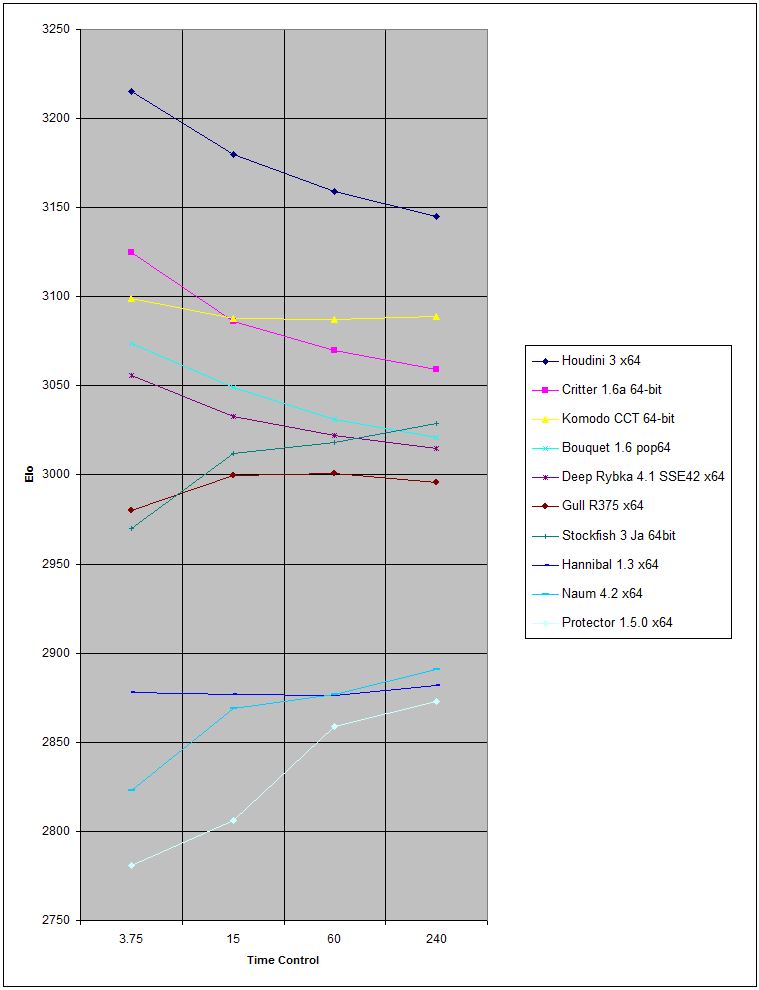Here are the results (Time controls: 3.75+0.0375, 15.00+0.15, 60.00+0.60 and 240.00+2.40 in seconds) and the corresponding diagram:


The 10 tested engines can be divided into three groups:
The balanced:
Komodo, Gull and Hannibal play at all time controls fairly balanced.
The losers:
Houdini, Rybka, Bouquet and Critter points over the competition especially good in shorter time controls. At longer time controls they lose in this experiment between 41 and 70 Elo.
The winners:
Protector, Naum und Stockfish increase their playing strength at longer time controls.
Stockfish 59 Elo, Naum 68 Elo and Protector even 92 Elo!
Code: Select all
ELOStat Start Elo: 3000
Programm | ELO | ELO | ELO | ELO |
| 3.75 | 15 | 60 | 240 | Diff.
-------------------------+------+------+------+------+------
Houdini 3 x64 | 3215 | 3180 | 3159 | 3145 | -70
Critter 1.6a 64-bit | 3125 | 3086 | 3070 | 3059 | -66
Komodo CCT 64-bit | 3099 | 3088 | 3087 | 3089 | -10
Bouquet 1.6 pop64 | 3074 | 3049 | 3031 | 3021 | -53
Deep Rybka 4.1 SSE42 x64 | 3056 | 3033 | 3022 | 3015 | -41
Gull R375 x64 | 2980 | 3000 | 3001 | 2996 | +16
Stockfish 3 Ja 64bit | 2970 | 3012 | 3018 | 3029 | +59
Hannibal 1.3 x64 | 2878 | 2877 | 2876 | 2882 | + 4
Naum 4.2 x64 | 2823 | 2869 | 2877 | 2891 | +68
Protector 1.5.0 x64 | 2781 | 2806 | 2859 | 2873 | +92
-------------------------+------+------+------+------+-----
Diff. | 434 | 374 | 300 | 272 | Code: Select all
Programm | Diff.|
-------------------------+------+
Houdini 3 x64 | -35 |
Critter 1.6a 64-bit | -27 |
Komodo CCT 64-bit | + 1 |
Bouquet 1.6 pop64 | -28 |
Deep Rybka 4.1 SSE42 x64 | -18 |
Gull R375 x64 | - 4 |
Stockfish 3 Ja 64bit | +17 |
Hannibal 1.3 x64 | + 5 |
Naum 4.2 x64 | +22 |
Protector 1.5.0 x64 | +67 |
-------------------------+------+The end result for all time controls with evaluation (Elo, Bayeselo and Ordo) and individual results are available on my website (Experimental Rating Lists).
http://www.fastgm.de
Regards,
Andreas
